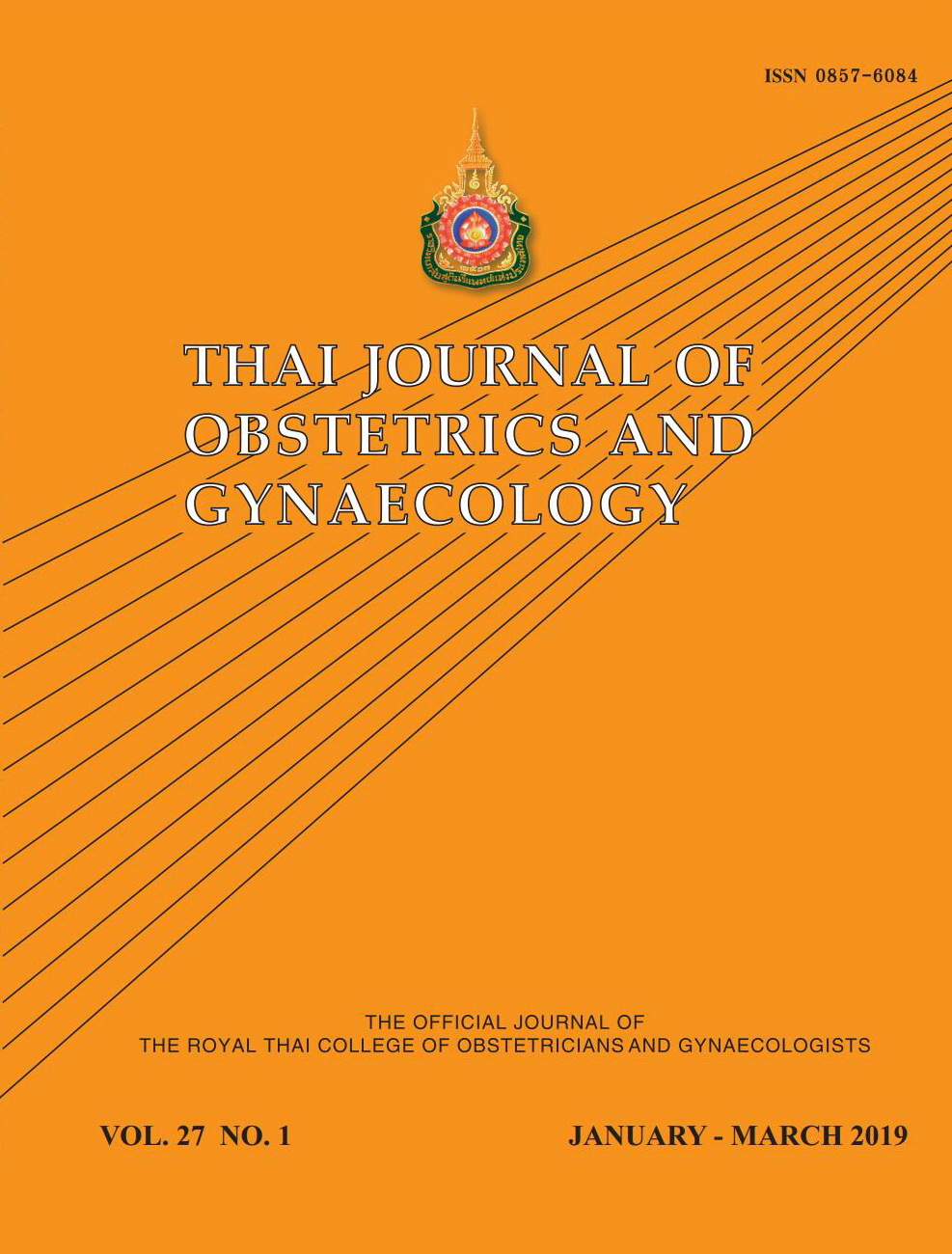Efficacy of Oral Isosorbide Mononitrate Sustained-release for Pre-induction Cervical Ripening in Term Pregnant Women in an Outpatient Setting: A randomized controlled trial
Main Article Content
Abstract
Objectives: To compare the efficacy of 60 mg oral, sustained-release, isosorbide mononitrate (ISMN SR) with a control for improve pre-induction cervical ripening of term pregnant women in an outpatient setting.
Materials and Methods: In this randomized controlled, superiority trial, 36 women with uncomplicated singleton pregnancy at ≥ 39 weeks gestation and unfavorable cervix attending the antenatal care clinic at Khon Kaen Hospital were randomly assigned to (a) two oral 60 mg doses of ISMN SR every 24 h (n=18) prior to admission for induction of labor or (b) a control group (n=18). The primary outcome was the proportion of favorable cervix on admission. The secondary outcomes were (a) changes in the Bishop score, (b) time from admission to delivery, and (c) neonatal and maternal outcomes.
Results: Demographic characteristics were similar between the groups. The proportion of favorable cervix at 48 h after oral ISMN SR was significantly greater than the control group (0.61 vs 0.17, p = 0.008, RR = 7.85, 95%CI 1.65-37.40). The mean change in the Bishop score was significantly higher in the ISMN SR group than the control (6.05 vs 2.71, p = 0.022). The time from admission to delivery in the ISMN SR was also less than the control (10 vs 23 h, p = 0.002). However, there was no respective significant difference in the rate of cesarean section, maternal complications, or neonatal outcomes.
Conclusion: Our study provides evidence that pre-induction of cervical ripening with 60 mg of oral ISMN SR among outpatient, term pregnant women is effective and with no observed adverse outcomes.
Article Details
References
2. Olesen AW, Westergaard JG, Olsen J. Perinatal and maternal complications related to postterm delivery: a national register-based study, 1978-1993. Am J Obstet Gynecol. 2003;189:222-7.
3. American College of Obstetricians and Gynecologists. ACOG Practice Bulletin No. 107: Induction of labor. Obstet Gynecol. 2009;114:386-97.
4. Leduc D, Biringer A, Lee I, Dy J. Induction of labor. J ObstetGynaecol Can. 2013;35:840-57.
5. Hofmeyr G, Gülmezoglu A. Vaginal misoprostol for cervical ripening and induction of labor. Cochrane Database Syst Rev. 2003;1:CD000941.
6. Eddama O, Petrou S, Schroeder L, Bollapragada SS, Mackenzie F, Norrie J, et al. The cost-effectiveness of outpatient (at home) cervical ripening with isosorbide mononitrate prior to induction of labour. BJOG. 2009;116:1196-203.
7. Reid M, Lorimer K, Norman JE, Bollapragada SS, Norrie J. The home as an appropriate setting for women undertaking cervical ripening before the induction of labour. Midwifery. 2011;27:30-5.
8. Bollapragada S, Mackenzie F, Norrie J, Petrou S, Reid M, Greer I, et al. IMOP: randomisedplacebo controlled trial of outpatient cervical ripening with isosorbide mononitrate (IMN) prior to induction of labour-clinical trial with analyses of efficacy, cost effectiveness and acceptability.BMC Pregnancy Childbirth. 2006;6:25.
9. Osman I, MacKenzie F, Norrie J, Murray HM, Greer IA, Norman JE. The "PRIM" study: a randomized comparison of prostaglandin E2 gel with the nitric oxide donor isosorbide mononitrate for cervical ripening before the induction of labor at term. Am J Obstet Gynecol. 2006;194:1012-21.
10. Vogel JP, Osoti AO, Kelly AJ, Livio S, Norman JE, Alfirevic Z. Pharmacological and mechanical interventions for labour induction in outpatient settings (Review).Cochrane Database Syst Rev. 2017;9:CD007701.
11. Vaisanen-Tommiska MR. Nitric oxide in the human uterine cervix: Endogenous ripening factor. Ann Med 2008;40:45-55.
12. Ledingham MA, Thomson AJ, Greer IA, Norman JE. Nitric oxide in parturition. BJOG 2000;107:581–93.
13. Bullarbo M, Norström A, Andersch B, Ekerhovd E. Isosorbide mononitrate induces increased cervical expression of cyclooxygenase-2, but not of cyclooxygenase-1, at term. Eur J ObstetGynecolReprod Biol. 2007;130:160-4.
14. Ghosh A, Lattey KR, Kelly AJ. Nitric oxide donors for cervical ripening and induction of labour. Cochrane Database Syst Rev. 2016;12:CD006901.
15. Nicoll AE, Mackenzie F, Greer IA, Norman JE. Vaginal application of the nitric oxide donor isosorbide mononitrate for preinduction cervical ripening: a randomized controlled trial to determine effects on maternal and fetal hemodynamics. Am J Obstet Gynecol. 2001;184:958-64.
16. Agarwal K, Batra A, Batra A, Dabral A, Aggarwal A. Evaluation of isosorbide mononitrate for cervical ripening prior to induction of labor for postdated pregnancy in an outpatient setting. Int J Gynaecol Obstet. 2012;118:205-9.
17. Bollapragada S, MacKenzie F, Norrie JD, Eddama O, Petrou S, Reid M, et al.Randomised placebo-controlled trial of outpatient (at home) cervical ripening with isosorbide mononitrate (IMN) prior to induction of labour-clinical trial with analyses of efficacy and acceptability. The IMOP study. BJOG. 2009;116:1185-95.
18. Habib SM, Emam SS, Saber AS. Outpatient cervical ripening with nitric oxide donor isosorbide mononitrate prior to induction of labor.Int J Gynaecol Obstet. 2008;101:57-61.
19. Schmitz T, Fuchs F, Closset E, Rozenberg P, Winer N, Perrotin F, et al. Outpatient cervical ripening by nitric oxide donors for prolonged pregnancy: a randomized controlled trial. Obstet Gynecol. 2014;124:1089-97.
20. Bullarbo M, Orrskog ME, Andersch B, Granström L, Norström A, Ekerhovd E. Outpatient vaginal administration of the nitric oxide donor isosorbide mononitrate for cervical ripening and labor induction postterm: a randomized controlled study. Am J Obstet Gynecol. 2007;196:50.e1-5.
21. Haghighi L, Moukhah S, Goshtasbi A. Comparing the effect of oral and vaginal isosorbide dinitrate in pre-induction cervical ripening in term pregnancy: A controlled clinical trial. Adv Biomed Res. 2015;4:129.
22. United States Food and Drug Administration. Drugs@FDA: FDA Approved Drug Products: Label: ISOSORBIDE MONONITRATE [Internet]. [cited 2016 Aug 10]. Available from: https://www.accessdata.fda.gov/drugsatfda_docs/label/2014/075155
Orig1s034lbl.pdf
23. Vidanagamage RS, Goonewardene IM. The efficacy of two different doses of vaginal isosorbide mononitrate in pre induction cervical ripening: a double blind randomized controlled trial. Ceylon Med J. 2011;56:91-100.
24. Rameez MF, Goonewardene IM. Nitric oxide donor Isosorbide mononitrate for pre-induction cervical ripening at 41 weeks' gestation: A randomized controlled trial. J ObstetGynaecol Res. 2007;33:452-6.
25. Väisänen-Tommiska M1, Nuutila M, Ylikorkala O. Cervical nitric oxide release in women postterm. Obstet Gynecol. 2004;103:657-62.

